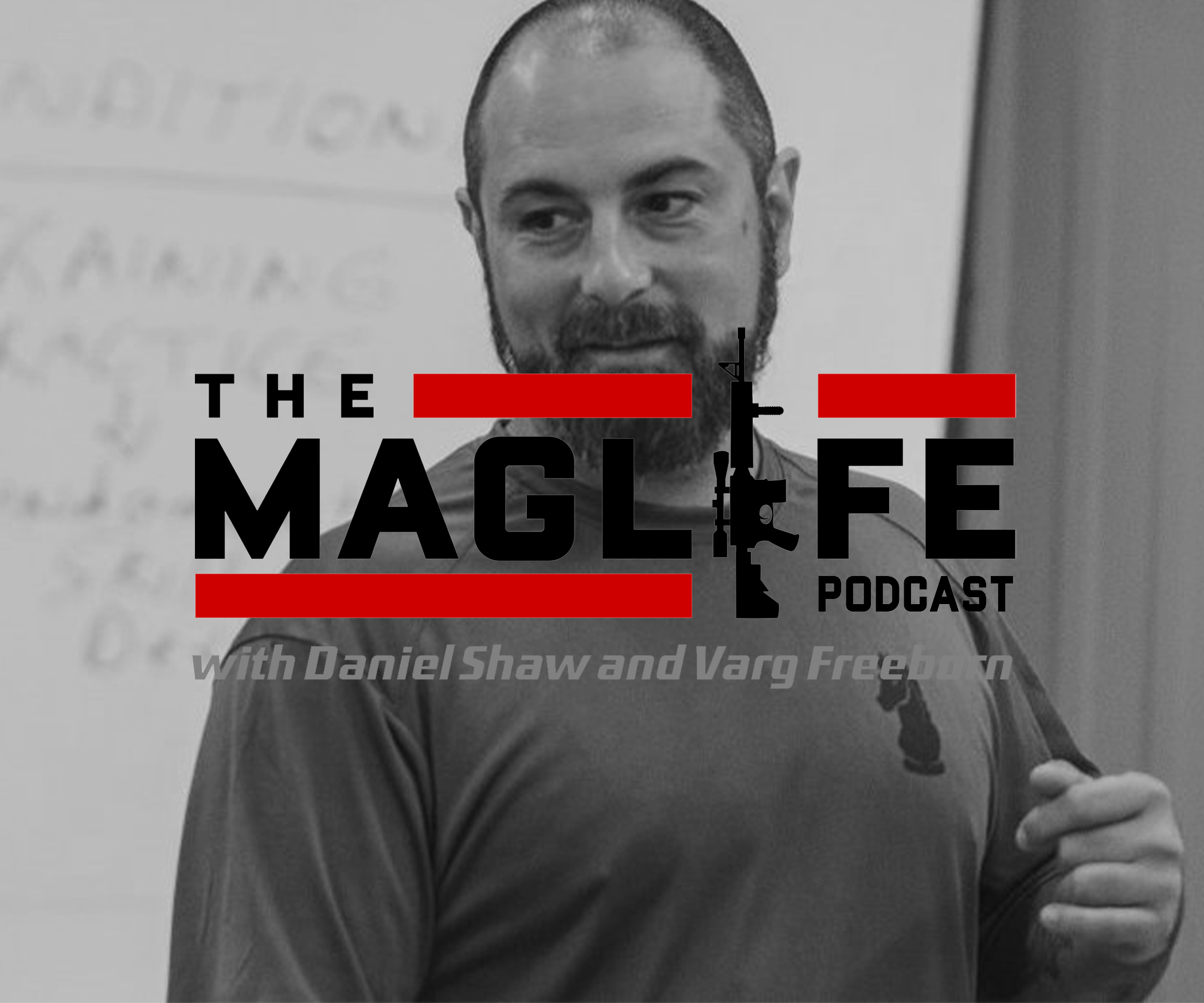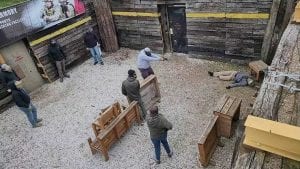183 – Beyond OODA: Varg Freeborn

In this week’s episode of the Mag Life Podcast, our esteemed co-host Varg Freeborn returns! This time around, Varg discusses the details of his newly released book, Beyond OODA: Developing the Orientation for Deception, Conflict, and Violence. In it, he presents a study of how the human mind reacts to and understands real-world violence. Together, Daniel and Varg unpack perception management, controlling one’s emotions and intentions, and self-orienting during violent encounters.
Host: Daniel Shaw
Guest (usual Co-Host!): Varg Freeborn
Introduction/Timeline: Eric Huh
Beyond OODA
00:26 Before you go out of the loop you have to understand it
In understanding the purpose of Varg’s latest book, one must understand what the OODA Loop even means. The “Observe, Orient, Decide, Act” concept was developed by military strategist Colonel John Boyd to help combatants process and make decisions on the battlefield. Since then, this thought method has been applied to everyday situations, especially in regards to reacting to sudden violence.
Varg’s Beyond the OODA focuses on the second “O” of the OODA Loop concept, specifically how the orientation phase relates to reacting and understanding real-world violence. Daniel speaks upon his experience as a training instructor and how this concept is widely misunderstood in the self-defense world.
“The ‘orientation’ is the foundation for all the other parts. So everything grows out of the orientation. The ‘observation’ feeds the ‘orientation’ but the ‘orientation’ colors what the observer is seeing and that then influences the ‘decision’ part.”
The OODA Loop is about processing information before making an action. Varg Freeborn emphasizes the orientation of that information.
Both Daniel and Varg believe that Boyd’s concepts, particularly the orientation process, should emphasize more of what’s already present or commonly known. In essence, the orientation process is taking on an individual’s previously held belief systems, traditions, behaviors, and attitudes to then make decisions off of. This holds true in an almost universal context, whether it is a business negotiation, a romantic relationship, driving in traffic, or in a fight.
06:46 How life experiences orient life decisions
Daniel draws upon real-world examples of how one’s upbringing and life experiences have influenced or otherwise oriented future decisions. At around the same time, Varg was entering the prison system as an inmate, Daniel was stepping on the yellow footprints at Parris Island to enter the United States Marine Corps Recruit Training. It was by the indoctrination, combat experience, comradery, and cultural traditions from the Marine Corps that Daniel developed his own value system that to this day he uses to navigate through his life.
Varg explains that while Daniel’s experience may indeed be unique from the vast majority of the population, the formula of how people think and gain experiences that eventually influence their decisions is the same. It is a false conclusion to assume that others do not think as you do. Daniel agrees, bringing up the common saying from firearm trainers that “Bad guys don’t think like you and me, they don’t make decisions like you and me” is in fact not true. Those who wish to do others harm do in fact use the same decision-making processes as the rest of us, criminals and evildoers are not inherently any less or more capable than the rest of society.
Varg further adds that the old warrior saying “To know your enemy is to know yourself” remains true. All cognitively capable human beings are capable of observing, making decisions, and choosing their actions. As such, Varg argues we operate under the same formula, adding that humans share the same weaknesses and aspects that can be exploited. That is why one of the most detrimental factors when entering any situation is uncertainty.
“If you’re going into a fight, the more uncertain you are about your own actions… [and] the outcomes of your own actions that you’re trying to predict, the less effective you’re going to be, the less committed you’re going to be… So you understand that about yourself, now you understand that about your enemy. You can say ‘if I can disrupt his confidence level or if I can disrupt his plan enough that he doesn’t feel like he can confidently predict the outcome of his plans anymore, then I have effectively begun to turn that fight in his mind.”
 Participating in violence without an understanding of your own capabilities or the capabilities of others is asking for a fatal outcome.
Participating in violence without an understanding of your own capabilities or the capabilities of others is asking for a fatal outcome.
16:30 Deception and perception management
Daniel builds off of Varg’s idea of knowing oneself as he brings up the notion of “true” concealment. This concept goes beyond simply just properly concealing a firearm on your person but the ability to conceal your intentions, knowledge, and the act of gathering information. Daniel argues that this ability to conceal actions is not possible without a firm understanding of the orientation piece of the OODA Loop.
 “Concealing” in a defensive setting goes far beyond simply hiding a gun with your shirt.
“Concealing” in a defensive setting goes far beyond simply hiding a gun with your shirt.
It is comparable to a Jujutsu match in which one combatant attempts one form of submission or tries to go a more advantageous position, the other combatant will react accordingly with his preconceived idea on how to counter. Varg agrees, adding that somewhat experienced Jujutsu practitioners will recognize an attack and immediately counter whereas the experienced black belts will allow an attack to unfold to trick their opponents into further compromising themselves. An experienced fighter will effectively conceal their intentions and manage their opponent’s perception of the fight in order to achieve victory in the least amount of effort.
“If you’re the type of person that doesn’t have self-control or you’re not acclimated to working at that level of stress, the likelihood of you being able to manage someone’s perceptions is very much lower because you aren’t in control of yourself so you can’t control what you’re projecting out into the atmosphere”
20:38 Beyond OODA: a deeper dive into the human psyche
Daniel expresses his high praise of Varg’s book and how it presents a comprehensive understanding of human behavior and mentality in relation to violence. Varg does not simply present anecdotal evidence for the sake of telling a story but supports each personal account with scholarly studies and subject matter experts.
Nowhere in Daniel’s extensive experience in the firearms or defense world has he found such a cohesive breakdown of the human condition during life or death situations. Varg asserts he does not ever try to “sell” anyone anything, that his book, Beyond the OODA, was created at the request of many who found value in his multifaceted experiences within the criminal world, prison system, and self-defense training.
27:54 Being honest with oneself, perception management outside of conflict
Varg makes the observation that so many today refuse to be honest with who they really are or the image they project, especially during the advent of social media. It has become socially accepted to be fake. Almost every piece of personal information put out into the world is now a specially curated piece of content meant to present a desired image, not an image as it truly is. Varg warns that there are consequences for constantly telling the public about your desires, beliefs, biases, and the like because this will be built into your own story. This self-projected part of yourself that is now made public can then be manipulated by others.
“When you can clearly determine the story that someone is telling themselves about.. who they want you to think they are, you literally gain the keys to their emotions and their actions… You get the keys to all of those locks.”
Out of the loop: Orientation is the foundation of mindset
32:22 What is the most important piece of information in the book?
Daniel asks Varg, what part of the book does he believe to be most important and most needed in regards to our current society. In the book itself, it is broken down into 3 main parts: origins, operating inward and operating outward. As discussed before, Varg feels individuals must first honestly understand and express how they operate inwards before they project outward into the world. He warns against excessively or incorrectly operating inwards or focusing too much on internal struggles that nothing is allowed to come out.
If you find yourself in a fight, hyper concerning yourself with what you’re afraid of may happen will prevent you from actually imposing any form of outward attack or defense of your own. This applies to everyday life as well, an individual is not truly living their life if they’re unable to impart any change into the world at all. As such, operating inwards in a healthy, productive manner is essential to understanding your place in the world. It creates the foundation to then influence the actions of others or to navigate the world without harm.
 There is no guarantee in a violent encounter, but you can better prepare for it with the right analytical mindset.
There is no guarantee in a violent encounter, but you can better prepare for it with the right analytical mindset.
35:32 Who is the audience of this book?
Daniel asks what the target audience of Beyond OODA is. Varg explains that unlike his last book, Violence of Mind, this book is not specifically targeted at the firearms community. This book is meant for the general population, anyone who works in education, law enforcement, military, criminal psychology, and just everyday citizens. Varg notes that his book is also meant for anyone who is unaware of how manipulation and deception occur every day in their lives.
36:50 Deception in everyday negotiations
Varg adds that the act of deception is not necessarily bad or detrimental. Part of understanding yourself and others around you is how you manage what you choose to reveal in order to attain a more beneficial end. That is essentially what daily forms of negotiation are.
Varg gives the example of haggling for a good deal when buying a used car from the lot. If one jumps up for joy the second they see a car after hearing the initial price tag, the dealer has already won the exchange and there will be no opportunity to ask for a lower price. However, if the buyer chooses to be more reserved in their emotions and start pointing out flaws in the vehicle before discussing purchasing, the chance of acquiring said vehicle at a lower price is more likely.
Daniel draws a comparison to how Varg’s book is very similar to a world-famous FBI hostage negotiation book, Never Split the Difference, in that both apply concepts of deception management and how to impose this upon others. The major difference is that Varg applies this to real-world violence and survival.
Daniel gives further praise to Beyond the OODA, that he promises viewers if they are not satisfied with the purchase of the book, they are welcome to email him and ask for a refund.
• Next up: Get the lowdown on all four letters of the loop
To purchase Varg Freeborn’s latest book, Beyond OODA: Developing the Orientation for Deception, Conflict, and Violence: https://beyondooda.com/.
Follow Varg on Instagram: https://www.instagram.com/vargfreeborn.
• More about OODA
Article/Show notes by Eric Huh
Podcast: Play in new window | Download
Subscribe: Spotify |


